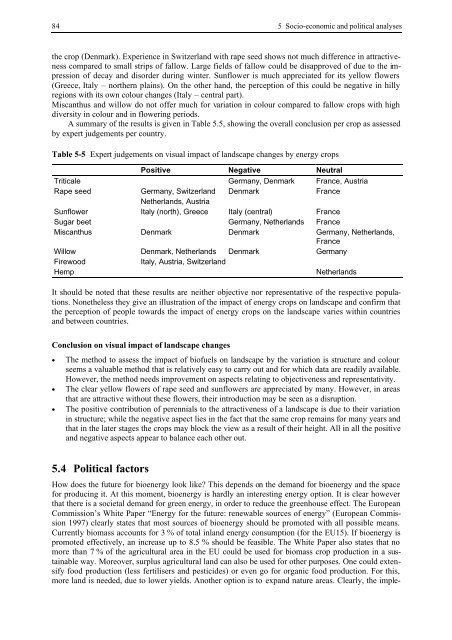BIOENERGY FOR EUROPE: WHICH ONES FIT BEST?
BIOENERGY FOR EUROPE: WHICH ONES FIT BEST?
BIOENERGY FOR EUROPE: WHICH ONES FIT BEST?
You also want an ePaper? Increase the reach of your titles
YUMPU automatically turns print PDFs into web optimized ePapers that Google loves.
84 5 Socio-economic and political analyses<br />
the crop (Denmark). Experience in Switzerland with rape seed shows not much difference in attractiveness<br />
compared to small strips of fallow. Large fields of fallow could be disapproved of due to the impression<br />
of decay and disorder during winter. Sunflower is much appreciated for its yellow flowers<br />
(Greece, Italy – northern plains). On the other hand, the perception of this could be negative in hilly<br />
regions with its own colour changes (Italy – central part).<br />
Miscanthus and willow do not offer much for variation in colour compared to fallow crops with high<br />
diversity in colour and in flowering periods.<br />
A summary of the results is given in Table 5.5, showing the overall conclusion per crop as assessed<br />
by expert judgements per country.<br />
Table 5-5 Expert judgements on visual impact of landscape changes by energy crops<br />
Positive Negative Neutral<br />
Triticale Germany, Denmark France, Austria<br />
Rape seed Germany, Switzerland Denmark France<br />
Netherlands, Austria<br />
Sunflower Italy (north), Greece Italy (central) France<br />
Sugar beet Germany, Netherlands France<br />
Miscanthus Denmark Denmark Germany, Netherlands,<br />
France<br />
Willow Denmark, Netherlands Denmark Germany<br />
Firewood Italy, Austria, Switzerland<br />
Hemp Netherlands<br />
It should be noted that these results are neither objective nor representative of the respective populations.<br />
Nonetheless they give an illustration of the impact of energy crops on landscape and confirm that<br />
the perception of people towards the impact of energy crops on the landscape varies within countries<br />
and between countries.<br />
Conclusion on visual impact of landscape changes<br />
• The method to assess the impact of biofuels on landscape by the variation is structure and colour<br />
seems a valuable method that is relatively easy to carry out and for which data are readily available.<br />
However, the method needs improvement on aspects relating to objectiveness and representativity.<br />
• The clear yellow flowers of rape seed and sunflowers are appreciated by many. However, in areas<br />
that are attractive without these flowers, their introduction may be seen as a disruption.<br />
• The positive contribution of perennials to the attractiveness of a landscape is due to their variation<br />
in structure; while the negative aspect lies in the fact that the same crop remains for many years and<br />
that in the later stages the crops may block the view as a result of their height. All in all the positive<br />
and negative aspects appear to balance each other out.<br />
5.4 Political factors<br />
How does the future for bioenergy look like? This depends on the demand for bioenergy and the space<br />
for producing it. At this moment, bioenergy is hardly an interesting energy option. It is clear however<br />
that there is a societal demand for green energy, in order to reduce the greenhouse effect. The European<br />
Commission’s White Paper “Energy for the future: renewable sources of energy” (European Commission<br />
1997) clearly states that most sources of bioenergy should be promoted with all possible means.<br />
Currently biomass accounts for 3 % of total inland energy consumption (for the EU15). If bioenergy is<br />
promoted effectively, an increase up to 8.5 % should be feasible. The White Paper also states that no<br />
more than 7 % of the agricultural area in the EU could be used for biomass crop production in a sustainable<br />
way. Moreover, surplus agricultural land can also be used for other purposes. One could extensify<br />
food production (less fertilisers and pesticides) or even go for organic food production. For this,<br />
more land is needed, due to lower yields. Another option is to expand nature areas. Clearly, the imple-

















